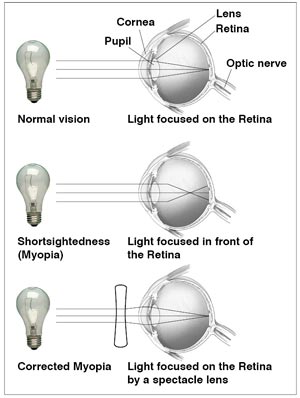A myopic eye is longer than normal or has a cornea that is too steep, so that the light rays focus in front of the retina. Close objects look clear, but distant objects appear blurred.
Treatment
 There are several alternatives to correct your vision. You should discuss your vision and your lifestyle with your Eye M.D. to decide which of these will be best for you.
There are several alternatives to correct your vision. You should discuss your vision and your lifestyle with your Eye M.D. to decide which of these will be best for you.
Eyeglasses or contact lenses are the most common methods of correcting refractive errors. They work by refocusing light rays on the retina, compensating for the shape of your eye.
Refractive surgery is also an option to correct or improve your vision. These surgical procedures are used to adjust your eye’s focusing ability by reshaping the cornea, or front surface of your eye.
Eyeglasses
Glasses are an easy way to correct refractive errors. They also can help protect your eyes from harmful light rays, such as ultraviolet (UV) light rays.
Bifocals are glasses used to correct presbyopia. They have a correction for reading on the bottom half of the lens and another for seeing at a distance on the top. Trifocals are lenses with three different lens corrections in one set of eyeglasses.
If you don’t need correction for seeing at a distance, you can receive a prescription for reading glasses or buy them over the counter to correct presbyopia.
You will probably need to change your prescription from time to time between the ages of 40 and 60, because your focusing ability will continue to decline.
Contact Lenses
Contact lenses are thin plastic discs that sit directly on the eye. There are a wide variety of contact lenses available. The best type for you depends upon your eyes and your lifestyle. If you want to wear contact lenses, discuss the various options with your ophthalmologist.
Refractive Surgery
Surgery can reduce or eliminate the need for glasses or contact lenses. Talk to your ophthalmologist about the potential for success, as well as the potential for complications. It is essential to make an informed decision about any surgical procedure.
LASIK (Laser In Situ Keratomileusis)
LASIK is a combined microsurgical and laser procedure to correct myopia, hyperopia and astigmatism. In LASIK, the surgeon uses a highly specialized instrument (microkeratome) to cut a thin flap in the cornea. This flap is folded back, and the excimer laser reshapes the cornea. Then, the flap is replaced and allowed to heal back into position. Read more about LASIK.
